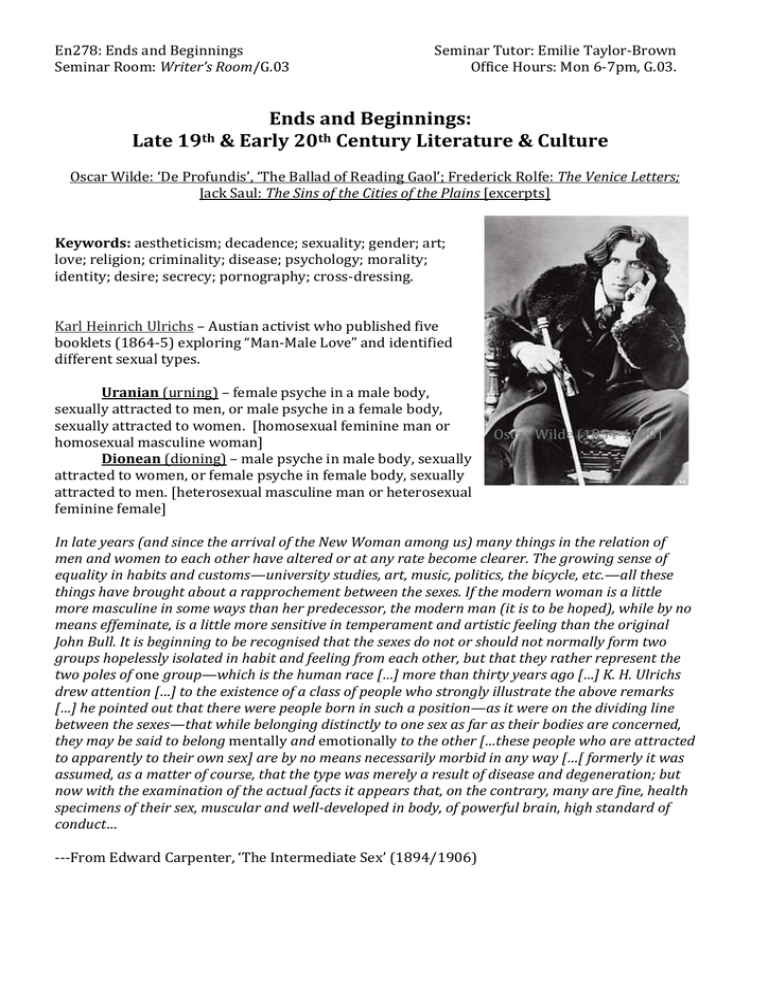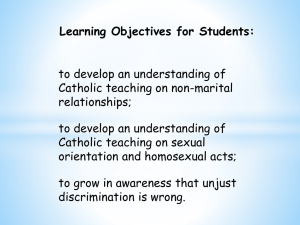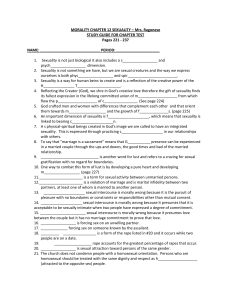
En278: Ends and Beginnings
Seminar Room: Writer’s Room/G.03
Seminar Tutor: Emilie Taylor-Brown
Office Hours: Mon 6-7pm, G.03.
Ends and Beginnings:
Late 19th & Early 20th Century Literature & Culture
Oscar Wilde: ‘De Profundis’, ‘The Ballad of Reading Gaol’; Frederick Rolfe: The Venice Letters;
Jack Saul: The Sins of the Cities of the Plains [excerpts]
Keywords: aestheticism; decadence; sexuality; gender; art;
love; religion; criminality; disease; psychology; morality;
identity; desire; secrecy; pornography; cross-dressing.
Karl Heinrich Ulrichs – Austian activist who published five
booklets (1864-5) exploring “Man-Male Love” and identified
different sexual types.
Uranian (urning) – female psyche in a male body,
sexually attracted to men, or male psyche in a female body,
sexually attracted to women. [homosexual feminine man or
homosexual masculine woman]
Dionean (dioning) – male psyche in male body, sexually
attracted to women, or female psyche in female body, sexually
attracted to men. [heterosexual masculine man or heterosexual
feminine female]
Oscar Wilde (1854-1900)
In late years (and since the arrival of the New Woman among us) many things in the relation of
men and women to each other have altered or at any rate become clearer. The growing sense of
equality in habits and customs—university studies, art, music, politics, the bicycle, etc.—all these
things have brought about a rapprochement between the sexes. If the modern woman is a little
more masculine in some ways than her predecessor, the modern man (it is to be hoped), while by no
means effeminate, is a little more sensitive in temperament and artistic feeling than the original
John Bull. It is beginning to be recognised that the sexes do not or should not normally form two
groups hopelessly isolated in habit and feeling from each other, but that they rather represent the
two poles of one group—which is the human race […] more than thirty years ago […] K. H. Ulrichs
drew attention […] to the existence of a class of people who strongly illustrate the above remarks
[…] he pointed out that there were people born in such a position—as it were on the dividing line
between the sexes—that while belonging distinctly to one sex as far as their bodies are concerned,
they may be said to belong mentally and emotionally to the other […these people who are attracted
to apparently to their own sex] are by no means necessarily morbid in any way […[ formerly it was
assumed, as a matter of course, that the type was merely a result of disease and degeneration; but
now with the examination of the actual facts it appears that, on the contrary, many are fine, health
specimens of their sex, muscular and well-developed in body, of powerful brain, high standard of
conduct…
---From Edward Carpenter, ‘The Intermediate Sex’ (1894/1906)
En278: Ends and Beginnings
Seminar Room: Writer’s Room/G.03
Seminar Tutor: Emilie Taylor-Brown
Office Hours: Mon 6-7pm, G.03.
There is a passion, or a perversion of appetite, which, like all human passions, has played a
considerable part in the world’s history for good or evil; but which has hardly yet received the
philosophical attention and scientific investigation it deserves. The reason for this may be that in all
Christian societies the passion under consideration has been condemned to pariahdom […] only one
great race in past ages, the Greek race, to whom we owe the inheritance of our ideas, succeeded in
raising it to the level of chivalrous enthusiasm. Nevertheless, we find it present everywhere and in
all periods of history […] sometimes it assumes the calm dignified attitude of conscious merit, as in
Sparta, Athens, Thebes. Sometimes it stalks in holes and corners, hiding its abashed head and
shrinking from the light of days, as in the capitals of modern Europe.
--- From John Addington Symonds, A Problem in Modern Ethics, Being an Inquiry into the
Phenomenon of Sexual Inversion, Addressed Especially to Medical Psychologists and Jurists (1896)
1. How do theorists present, and account for, homosexual behaviour?
2. How does Carpenter explain the relationship between ‘Urnings’ and pathology? Do
you think this is a liberal or conservative theory of sexuality?
Sexuality, Society and Biopower
The sexual conduct of the population was taken as both an object of analysis and as a target for
intervention; there was a progression from the crudely populationist arguments of the mercantile
epoch to the much more subtle and calculated attempts at regulation that tended to favour, or
discourage—according to the objectives and exigencies of the moment—an increasing birthrate.
[…] there also appeared those systematic campaigns, which, going beyond the traditional means—
moral and religious exhortations, fiscal measures—tried to transform the sexual conduct of couples
into a concerted economical and political behaviour. (Foucault, 26)
Through the various [sexual] discourses, legal sanctions against minor perversions were multiplied;
sexual irregularity was annexed to mental illness; from childhood to old age, a norm of sexual
development was defined and all the possible deviations were carefully described; pedagogical
controls, and medical treatments were organised; around the least fantasies, moralists, but
especially doctors, brandished the whole emphatic vocabulary of abomination […was this not]
motivated by one concern, to reproduce labour capacity, to perpetuate the form of social relations:
in short to constitute a sexuality that is economically useful and politically conservative.? (Foucault,
37)
The nineteenth-century homosexual became a personage, a past, a case history, and a childhood, in
addition to being a type of life, a life form, and a morphology, with an indiscreet anatomy and
possibly a mysterious physiology. Nothing that went into his total composition was unaffected by
his sexuality. It was everywhere present in him: at the root of all his actions because it was their
insidious and indefinitely active principle; written immodestly on his face and body because it was a
secret that always gave itself away. It was consubstantial with him, less as a habitual sin than as a
singular nature. We must not forget that the psychological, psychiatric, medical category of
homosexuality was constituted from the moment it was characterized—Westphal's famous article
of 1 870 on "contrary sexual sensations" can stand as its date of birth—less by a type of sexual
relations than by a certain quality of sexual sensibility, a certain way of inverting the masculine and
the feminine in oneself. Homosexuality appeared as one of the forms of sexuality when it was
transposed from the practice of sodomy onto a kind of interior androgyny, a hermaphrodism of the
soul. The sodomite had been a temporary aberration; the homosexual was now a species. (Foucault,
43)
En278: Ends and Beginnings
Seminar Room: Writer’s Room/G.03
Seminar Tutor: Emilie Taylor-Brown
Office Hours: Mon 6-7pm, G.03.
1. What does Foucault argue in his ‘Repressive Hypothesis’?
2. According to Foucault, how does sexuality function in relation to social
governance?
3. How does Foucault discuss the emergence of sexual identity in the nineteenth
century, and what is the significance of this shift from a criminal behaviour to a
‘hermaphrodism of the soul’?
4. In relation to the set texts, how does this understanding of homosexual “identity”
function? Is it positive, negative or both?
Sexuality and the Law
The petition of above named prisoner humbly sheweth that he does not desire to attempt to palliate
in any way the terrible offences of which he was rightly found guilty, but to point out that such
offences are forms of sexual madness and are recognised as such not merely by modern
pathological science but by modern legislation, notably in France, Austria, and Italy, where the laws
affecting these misdemeanours have been repealed, on the ground that they are diseases to be
cured by a physician, rather than crimes to be punished by a judge.
--- Letter to the Home Secretary, July 1896.
[Your mother spoke of your vanity, your temper and your recklessness with money] of the
degeneration and change that had taken place in you. She saw, of course, that heredity had
burdened you with a terrible legacy, and frankly admitted it, admitted it with terror. (Wilde, 58)
1. What is the connection between criminal lunatics, artists, and homosexuals, and
how did Wilde try to exploit this?
2. Explore the relationships between sexual, medical, legal, and artistic identity.
3. How to these discourses interact with other texts on this module? Particularly in
relation to fears of degeneration, gender anxiety, and English national identity.
4. How do non-heteronormative authors try to combat the pathologisation of
sexuality?
Homosexual love
“Every great love has its tragedy, and now ours has too, but to have known and loved you with
such passion and devotion, to have had you for a part of my life, the only part I now consider
beautiful, is enough for me. My passion is at a loss for words, but you can understand me, you
alone. Our souls were made for one another, and by knowing yours through love, mine has
transcended many evils, understood perfection, and entered into the divine essence of things.”
--- Letter to Lord Alfred Douglas, May 1895.
1. Consider the above quotation in dialogue with Plato’s “Divine Eros” (platonic love),
in which carnal love is transformed into its ideal form – love for supreme beauty, a
love that can lead man to divinity.
En278: Ends and Beginnings
Seminar Room: Writer’s Room/G.03
Seminar Tutor: Emilie Taylor-Brown
Office Hours: Mon 6-7pm, G.03.
“I have had moments when I thought it would be wiser to separate. Ah! Moments of weakness
and madness! Now I see that that would have mutilated my life, ruined by art, broken the
musical chords which made a perfect soul […] Love me always, love me always. You have been
the supreme, the perfect love of my life; there can be no other.”
--- Letter to Lord Alfred Douglas, May 1895.
I had given you my life, and to gratify the lowest and most contemptible of all human passions,
Hatred and Vanity and Greed, you had thrown it away. In less than three years you had entirely
ruined me from every point of view. For my own sake there was nothing for me to do but to love
you. I knew if I allowed myself to hate you, that in the dry desert of existence over which I had to
travel, and am travelling still, every rock would lose its shadow, every palm tree be withered, every
well of water prove poisoned at its source. (Wilde, 82)
2. Explore the connection between Truth, Beauty, and Divinity.
3. How do the authors depict homosexual “love” in addition to, and as distinct from,
sexual desire?
4. How do the authors characterise the sexual desires of homosexuals?
5. How do the authors navigate the idea of homosexuality as an identity, or as a
behaviour?
Homosexuality and Purity
“He himself began at 13 or thereabouts in this way. One of his cousins being left an orphan
suddenly came to live in his house and sleep in his bed. The cousin was 14 and, the bed being
narrow, there was a certain mixture which pleased both. And suddenly both spat together […]
this being very diverting they hugged and hugged, belly to belly, and did it again. So for many
nights, then a whore ate 80 francs of his elder brother, aet. 20, and gave him a disease, very
disgraceful and disturbing to the family. Whereat, he and his cousin congratulated themselves on
knowing a safer pleasure, and vowed to touch no whores.” (Rolfe, 30)
“Then some great fat slow cow of a girl will just open herself wide, and lie quite still, and drain
him dry. First, the rich bloom of him will go. Then he’ll get hard and hairy. And by July he’ll have
a moustache, a hairy breast and […] be just the ordinary stevedore to be found by scores on the
quays.” (Rolfe, 37)
“Boys who like sporting with their own sex are rare. Oughtn’t they therefore be made welcome
and carefully cultivated when they’re found? And isn’t this a fact also? Given a boy, a fine strong
healthy boy, who does actually enjoy the love of a male with all its naked joys, who burns for it,
seeks it, flings himself gleefully into the ardent strivings of it with no reserve, with utter and
entire abandon, offering himself a willing sacrifice, or operating in turn with equal and greedy
unreservedness, is it not a fact that such a one keeps his youthful freshness and vigour infinitely
longer than the ordinary lad who futters the ordinary lass from puberty on? And isn’t it also true
that the passionate boy must have an outlet for his passion; and, if he (preferring the male) can’t,
for whatever reason, have what his nature prefers, doesn’t he almost automatically sink into the
arms of a female and instantly become “man-like” […] unless they are used and cultivated now,
they will flower at Easter, fruit at Midsummer, and be fallen by the Autumn. (Rolfe, 37)
1. How does Rolfe depict homosexual relationships?
En278: Ends and Beginnings
Seminar Room: Writer’s Room/G.03
Seminar Tutor: Emilie Taylor-Brown
Office Hours: Mon 6-7pm, G.03.
2. How does pederasty complicate the performativity of gender?
3. Consider the association of homosexual adolescents with purity – the “safer
sweeter way”, and the implications of this for the portrayal of women’s sexuality.
4. How are homosexual practices aligned with youth, aestheticism and beauty?
Art and Sexuality
The supreme vice is shallowness (46)
Terrible as what you did to me was, what I did to myself was far more terrible still. I was a man who
stood in symbolic relations to the art and culture of my age. […] I treated Art as the supreme reality,
and life as a mere mode of fiction: I awoke the imagination of my century so that it created myth
and legend around me: I summed up all systems in a phrase and all existence in an epigram. Along
with these things, I had things that were different. I let myself be lured into long spells of senseless
and sensual ease. I amused myself with being a flaneur, a dandy, a man of fashion, I surrounded
myself with the smaller natures and meaner minds. (100)
Truth in Art is not any correspondence between the essential idea and the accidental existence; it is
not the resemblance of shape to shadow, or of the form mirrored in the crystal to the form itself […]
Truth in Art is the unity of a thing with itself: the outward rendered expressive of the inward; the
soul made incarnate: the body instinct with spirit. (110)
Art is a symbol because man is a symbol. It is, if I can fully attain to it, the ultimate realisation of the
artistic life. For the artistic life is simple self-development. Humility in the artist is his frank
acceptance of all experiences, juts as Love in the artist is simply that sense of Beauty that reveals to
the world its body and soul. […Christ recognised] in the entire sphere of human relations
imaginative sympathy, which in the sphere of Art is the sole secret of creation. He understood the
leprosy of the leper, the darkness of the blind, the fierce misery of those who live for pleasure, the
strange poverty of the rich. (114)
I will begin by telling you, I blame myself terribly. As I sit here I this dark cell in convict clothes, a
disgraced and ruined man, I blame myself […] I blame myself for allowing an unintellectual
friendship, a friendship whose primary aim was not the creation and contemplation of beautiful
things, to entirely dominate my life. (47)
1. How does Wilde reconcile his identity as an artist with his identity as a
homosexual?
2. What is the connection between love and art for Wilde?
3. How does Wilde see the relationship between art and truth?
4. How does De Profundis modify Wilde’s earlier ideas about Art?
5. How do the authors present the relationship between Art and sexuality?
General Points to Consider
- How is secrecy entwined with homosexual encounters?
- How is gender problematized in these texts?
- How do the authors depict women and heterosexual relationships?
- How can we read emergent non-heteronormative identities in these texts?
- What is the significance of the autobiographical or memoir format?
- Consider the power relations at work in these representations of homosexual relationships.








